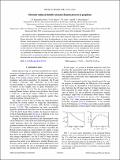Disorder-induced double resonant Raman process in graphene
Author(s)
Rodriguez-Nieva, J. F.; Barros, Eduardo B.; Saito, R.; Dresselhaus, Mildred
DownloadPhysRevB.90.235410.pdf (395.7Kb)
PUBLISHER_POLICY
Publisher Policy
Article is made available in accordance with the publisher's policy and may be subject to US copyright law. Please refer to the publisher's site for terms of use.
Terms of use
Metadata
Show full item recordAbstract
An analytical study is presented of the double resonant Raman scattering process in graphene, responsible for the D and D′ features in the Raman spectra. This work yields analytical expressions for the D and D′ integrated Raman intensities that explicitly show the dependencies on laser energy, defect concentration, and electronic lifetime. Good agreement is obtained between the analytical results and experimental measurements on samples with increasing defect concentrations and at various laser excitation energies. The use of Raman spectroscopy to identify the nature of defects is discussed. Comparison between the models for the edge-induced and the disorder-induced D-band intensity suggests that edges or grain boundaries can be distinguished from disorder by the different dependence of their Raman intensity on laser excitation energy. Similarly, the type of disorder can potentially be identified not only by the intensity ratio [ [I subscript D] over [I subscript D′]], but also by its laser energy dependence. Also discussed is a quantitative analysis of quantum interference effects of the graphene wave functions, which determine the most important phonon wave vectors and scattering processes responsible for the D and D′ bands.
Date issued
2014-12Department
Massachusetts Institute of Technology. Department of Electrical Engineering and Computer Science; Massachusetts Institute of Technology. Department of PhysicsJournal
Physical Review B
Publisher
American Physical Society
Citation
Rodriguez-Nieva, J. F. et al. “Disorder-Induced Double Resonant Raman Process in Graphene.” Physical Review B 90.23 (2014): 235410-1-9. © 2014 American Physical Society
Version: Final published version
ISSN
1098-0121
1550-235X